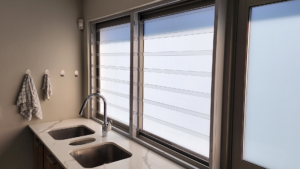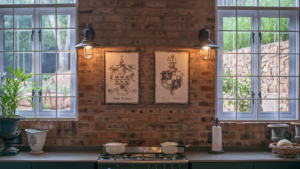All over the globe the COVID-19 virus has created a new norm in the world of work. Before the pandemic, it was only people in IT or perhaps social and other online media that worked from home. There were some that used shared office space or hot desks, too. The virus has changed all that, and the number of people working from home now out-weighs those going into the office.
Working from home is by no means the easy option, especially if you live with family or other people. It takes self-discipline, flexibility, good time management and organizational skills, a proactive approach to life and a professional attitude towards your work.
And, of course, it requires a home office.
How to create a home office
Not everyone has the luxury of space for a home office, but it is imperative to have a space, no matter how small, that is a designated work area.
Here are four tips on how to create a home office space and make it conducive to working productively.
- Create a separate home office space
It is really important to have a defined workspace at home so that when you sit down there, your family knows that you are now ‘at work’ and must minimize disruptions. It also reminds you that it’s time to switch off from ‘family mode’ to ‘work mode’ and avoid distractions.
A proper workspace that is organized allows you to be more professional. If it only stores work-related information and tools, you won’t have to scratch around in an unprofessional manner when the boss or a client calls, or worse, video calls you.
You also need a place to lock up, close off or switch off to indicate the end of your workday. Separating your functions when you operate from home is difficult but necessary to create a healthy work/life balance. Symbolically ‘closing off’ at the end of the day helps to define the boundaries, even if it is just closing your computer for the night.
So where could you create a home office within your space? If you have a large home, then it should be easy to find a workspace. Choose a spare room or convert the dining room or even move into the garage.
A small apartment or a tiny house in a complex presents more of a problem, but one that can be overcome with some creativity. Could you convert a cupboard, for example? Take out the bottom shelves to make legroom and use the rest of the shelves as a desk and storage.
Or how about one end of your dining area table or breakfast nook? Or buy an inexpensive computer desk that can be squeezed into a corner somewhere. Another idea is to install a shelf that’s wide enough for your computer under a window. Or find a lap desk online and sit in the comfort of your couch.
- Make your home office conducive to working
Once you have your designated office area, your next task is setting up it up to make it conducive to working. Some people can work very productively in chaos, but most of us need some order to be able to think straight.
If you’re already working from home, start by getting rid of the clutter in your home office. If you don’t want to bin the clutter, then box it, remembering to label the boxes so that you know where to find everything. Stacked boxes can look quite attractive in an office if done neatly and kept that way.
Find a comfy chair to work on. Hours of sitting in an unsupportive chair leads to backache and lower productivity. If you invest in one item only for your home office, this should be it! A chair that can be lowered or raised to suit your height and that of your desk is a good option.
A stimulating outlook can add to productivity, so the shelf-under-the-window idea isn’t so crazy if you have a good view. You could also paint the office wall or walls in a lovely neutral colour and add a pot plant or two to lower stress levels.
Good lighting is important to avoid eye strain, so add a good reading lamp to your desk area, particularly if you work at night like most parents of young children.
- Set up reliable connectivity
If you need to stay in touch with colleagues or clients, you need to be reachable during your work hours. This means good quality wi-fi with fast upload and download speeds. If you have fibre in your area, now is the time to get connected this way.
Get yourself some headphones so that you aren’t fiddling with small earpieces that fall out at critical moments. They will also cancel out background noise so that you can concentrate while the children are playing within earshot.
Power outages are going to return once the national lockdown lifts, apparently, so if working from home is going to remain a feature of your life, invest in some backup in order to stay in contact. This could include a UPS for your computer and a power bank for your cell phone.
If video meetings are a feature of your work-from-home commitments, then make sure the background behind you is neutral. No-one likes to see distracting pictures or family photos around your face during meetings. A blank wall is best, if possible, especially since family members won’t be able to accidentally walk behind you during a meeting.
- Secure your home office
House robbery dropped substantially during the first phase of the national lockdown but is rising again as the lockdown eases. A secure home office should therefore be part of your workspace plan. Any security you install in your work area will also benefit your family, so spend some time planning how you will all keep safe at home.
Security products for home offices are the same as for the rest of your home. You need some good window security options for home office windows and reliable door security too. If you have an alarm system, keep a panic button close by while you work.
Here are some suggestions for home office security barriers:
- Protect your home office windows with burglar bars. If you are on a tight budget and the risk of a break-in is low, consider budget-friendly security products such as framed Polycarbonate bars, well-priced steel burglar bars like Trellidor Burglar Guard or Trellidor Fixed burglar proofing.
If you have a bit more budget to play with and would prefer burglar proofing that is less visible, consider security screens or security louvres. They both look lovely and provide a high level of protection.
- If you have doors in your home office that lead to the outside, make sure you stop intruders catching you unawares by installing a security gate here. Potential products includes sliding steel gates, a security screen in a format to match your door or a louvre door with built-in security features.
A home office that is in a garden shed or a garage separated from the house may require more in the way of security to protect your electronic equipment and anything else of value. A roller shutter will create a complete lockdown, so is a good option here. Alternatively, a high-grade sliding security gate and burglar proofing on windows will provide excellent protection against a break-in.
For more ideas on how to secure your home office, contact your nearest Trellidor franchise



